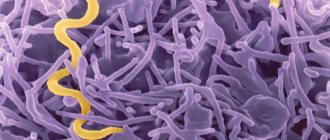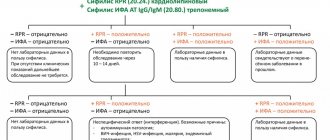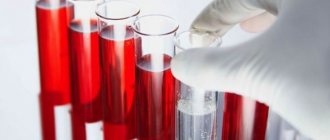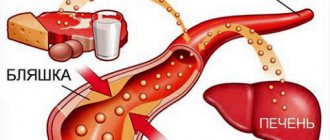Almost everyone knows about the natural protein dye of the most important fluid in our body - hemoglobin, but few know what Hgb is in a blood test. It turns out that this abbreviation means the same thing, only for convenience, in laboratory research forms it is customary to use the abbreviated name of the indicator, as in principle with other coefficients.
Hemoglobin is one of the most important parameters that can show the general condition of the human hematopoietic system and deviations of other organs associated with it. That is why, at the first visit to a doctor with complaints of poor health, a general (clinical) blood test is prescribed, thanks to which Hgb (Hb) and other important indicators are determined.
Types of hemoglobin and its norm
The hgb level in men is from 120 to 180 g/l, in women – from 120 to 140 g/l. Hemoglobin has different forms depending on the element it is attached to. Forms can be physiological and pathological:
- Oxyhemoglobin is a complex of hgb with oxygen molecules. Its main share is in arterial blood, which is why it is red. The complex provides cells and tissues with oxygen. With a deficiency of oxyhemoglobin, tissues are in a state of hypoxia.
- Carboxyhemoglobin is a compound of hgb with carbon dioxide that gives the blood a dark cherry color. Hydrocarbon molecules bind to hemoglobin after it gives oxygen to cells. The carboxyhemoglobin content increases with smoking and increased levels of carbon monoxide in the inhaled air (during fires, gas leaks from heating appliances).
- Glycated hemoglobin is a compound of hgb with glucose. In a standard blood sugar test, its level is determined at the time of donation. Glycated hemoglobin reflects the level of glucose in the blood for 3 to 4 months. The higher the indicator, the higher the level of glycemia in recent months and the greater the risk of developing complications of diabetes.
- Methemoglobin is determined in the blood when red blood cells are exposed to nitrites and nitrates. Under their influence, normal protein is converted into methemoglobin, which is a pathological form. Due to its presence, the blood turns chocolate brown and the skin becomes cyanotic.
- Fetal hemoglobin (fetal) is a physiological form. It is synthesized during the period of placental growth (from 6 to 7 weeks). From week 11, fetal hgb turns into embryonic. The fetal hemoglobin level at birth is about 80%. Its synthesis slows down during the first year of life; normally, by the age of three, its level corresponds to adults.
On average, one red blood cell contains 400,000,000 hemoglobin molecules. Hgb includes 2 components - the protein globin, which accounts for 96%, and heme, consisting of iron, accounting for 4%. Heme can attach oxygen only if its valence is 2. In the presence of free radicals (oxidizing agents) in the liquid, divalent iron becomes trivalent, which is not able to attach oxygen and the body begins to suffer from hypoxia. Antioxidants (vitamin A, C, E, etc.) prevent the formation of ferric iron.
Important! Carbon dioxide molecules must be removed from the body; if this does not happen, the blood begins to acidify.
Platelets in the blood and their coefficients
The most important component of the circulatory system are platelets (PLT). Their task is to ensure proper blood clotting, preventing blood loss as a result of mechanical damage to the veins and arteries. The normal level of PLT in the blood is 180-320*109/l. But after some surgical operations and in case of congenital pathologies of the circulatory system, these indicators may be underestimated. Low platelet counts are also observed in severe liver diseases. Platelets have several indices and coefficients. Thus, the large platelet index P LCR is important for diagnosing pathologies of the spinal cord, in case of intoxication of the body, and identifying viral infections and parasites in the human body. The next platelet index is PDW (platelet index). PDW indicates how evenly and widely platelets are distributed in the blood. The normal PDW for adults is 15 to 17% because it is expressed as a percentage. PDW indicates how platelets differ in size and whether they are uniform.
Pathologies such as anemia and inflammatory processes in various internal organs lead to an increase in PDW in the blood. The platelet index PDW also increases with malignant tumors in the body. Deviations from PDW norms to a greater extent are observed in patients who have undergone surgery and extensive blood loss. But intense physical activity and some medications can reduce PDW levels. PDW also decreases during menstruation in women and while expecting a baby. Food eaten before blood collection can affect your PDW, so it is important to take a blood test on an empty stomach, avoid heavy meals and limit exercise. The next platelet index is thrombocrit (PCT). The PCT index, which is also expressed as a percentage, shows the ratio of the total platelet volume to the blood volume. The PCT norm for adults is 0.10 to 0.28%. If the PCT level decreases, the volume of platelets in the blood is falling and bleeding will be difficult to stop. A high PCT indicator indicates a high risk of developing thrombosis, thrombophlebitis and overall blood density.
Chronic endocrine diseases, pathologies of the digestive system, respiratory system, joints and bones also increase the level of thrombocrit (PCT). A low PCT level is dangerous because it is a sign of quite severe pathologies that require complex and lengthy treatment.
Methods for determining hgb
The amount of hgb is determined by analyzing its derivatives, which are formed during the oxidation and addition of chemical elements. Methods:
- Colorimetric (hemichromic, calibration, hemiglobincyanide). Chemical elements are added to the blood being tested and the hgb level is determined depending on the shade of the resulting solution.
- Gasometric is a complex and time-consuming research method with high accuracy. Its essence is the oxidation of blood in an alkaline environment using special chemical reagents.
- Determination of iron level in hgb. Its amount is determined using a spectrophotometer, after adding reagents (acids or amino acids) to the blood and obtaining an ultraviolet spectrum.
The most informative methods are: spectrophotometric, Sali, chemical, saponin, but they are very labor-intensive, so laboratories use them extremely rarely.
Types of white blood cells
To prevent harmful substances from multiplying, leukocytes – white blood cells – “work” in the blood. Unlike red blood cells, white blood cells are quite large in size, but there are very few of them. Leukocytes are divided into two types - LYM and GRA. LYM are lymphocytes and GRA are granulocytes. If the total number of “virus blockers” is from 4.0 to 9.0 and is measured in pieces per ml of blood, then LYM and GRA are the ratio of subtypes of leukocytes to their total number, it is measured as a percentage. Lymphocytes (LYM) are bodies responsible for the functioning of the immune system. In the forms of various laboratories, LYM is indicated in units, but most often their norm ranges from 25 to 40%. Lymphocytes (LYM) in the blood may be higher or lower than acceptable values. Both positions pose danger. If the LYM norm is exceeded, the patient is usually diagnosed with various blood diseases, for the treatment of which medications that kill the immune system are prescribed.
And this reduces both the total number of leukocytes and lymphocytes (LYM) - the basis of the body’s defenses. The next type of leukocyte is granulocyte (GRA). These are substances that look like grains due to the granules they contain. Granulocytes (GRA) are basophils, neutrophils and eosinophils. The GRA's job is to destroy all harmful compounds that enter the human body. Granulocytes (GRA) “enter into battle” with representatives of pathogenic microflora, leading to the development of infectious diseases, inflammation and allergic reactions. Like lymphocytes (LYM), granulocytes (GRA) are indicated as a percentage, less often - in absolute numbers. The GRA norm is 47-72% of the total leukocyte volume. Connective tissue pathologies, as well as certain types of medications, can reduce the GRA level. If the permissible GRA parameters are exceeded, then an inflammatory process is present in the patient’s body.
Preparation for analysis, indications
The amount of hgb is determined during a general blood test. It includes determining the level of platelets, leukocytes, and erythrocytes. More often, an hgb test is prescribed for suspected anemia or for preventive purposes in pregnant women and children. Also, a hemoglobin test is necessary for injuries or diseases accompanied by blood loss.
For analysis, blood is taken from a fingertip. The results of a blood test for hgb indicate its level and standard values. Decryption takes 1 – 2 days. For the reliability of the result it is necessary:
- eliminate physical activity during the day;
- do not smoke on the day of the test;
- donate blood on an empty stomach;
- eliminate alcohol at least 48 hours in advance;
- do not take medications 3–4 days before the test (if they cannot be stopped, you need to warn your doctor).
When testing for glycated hemoglobin, venous blood is taken. Preparation for it is not required, since the sample reflects the hemoglobin level for 2 - 3 months.
Important! If women donate blood during menstruation, then due to blood loss the indicator may be lower than normal and the result will be uninformative.
Who is this study for?
A general blood test is prescribed to all people who come to doctors with complaints about their health, as well as to all hospital patients. Thanks to this study, it is possible to easily identify diseases at the earliest stages of their development, and therefore a general analysis is usually carried out as an annual screening study.
Based on the results of the study, it is possible not only to determine the presence of diseases of the internal organs, but to determine how functional the blood of each person is: does it deliver enough oxygen to the organs, does it have enough nutrients, is it able to protect against infections and ensure homeostasis? The symptoms of many diseases are similar. In the presence of pathologies of a variety of organs and systems, a person may feel the same symptoms: dizziness, fever, vomiting, pain and cramping in the stomach, suffer from diarrhea or constipation, headaches and body aches. By donating blood for a general analysis, you can accurately determine the source of the ailment, based on the deviation from the permissible parameters of certain blood components.
A general blood test is prescribed to all people, regardless of gender and age. This is an informative study that helps identify diseases both in the baby’s first days of life and in older people.
Degrees of anemia
Anemia or anemia is a decrease in the level of iron-containing protein. Anemia is a symptom of a disease that has led to a drop in hemoglobin and is not an independent disease. If hgb is reduced in the analysis results, then indicate the degree of anemic condition:
- Light (hgb up to 90 g/l). Manifests itself with mild symptoms: fatigue, weakness, sweating.
- Medium (from 70 to 90 g/l). Moderate symptoms: dry skin, constant fatigue (in the absence of exercise), arrhythmia, headache, dizziness, shortness of breath, cracks in the corners of the mouth.
- Heavy (below 70 g/l). A pronounced clinical picture of anemia: pale skin, numbness of the extremities, impaired sense of smell and taste, changes in the structure of the nails, hair loss, destruction of tooth enamel.
With severe anemia, pre-fainting and loss of consciousness are possible.
Causes and symptoms of decreased hgb
A decrease in hemoglobin levels (iron deficiency anemia, hemoglobinopenia) can cause:
- parasitic diseases;
- bone marrow damage;
- chronic hepatitis;
- strict diet;
- vegetarianism;
- changes in blood composition;
- bleeding;
- pneumonia;
- autoimmune pathologies;
- tuberculosis;
- abuse of strong coffee;
- disruption of the process of hormone synthesis by the ovaries and thyroid gland;
- impaired absorption of iron;
- starvation;
- alcohol;
- oncological diseases.
With reduced hemoglobin, cells and tissues suffer from a lack of oxygen and excess carbon dioxide. The first changes occur in skin cells, hair and nails. The body tries to compensate for the lack of oxygen - it saves energy and redistributes its reserves. Which manifests itself as weakness, headache, dizziness. If hemoglobin does not increase or levels continue to decrease, symptoms will worsen, causing:
- menstrual irregularities;
- weight loss;
- dysfunction of the genital organs in men;
- decreased immunity;
- dysfunction of the heart, central nervous system, lungs;
- delayed mental and physical development in children.
A progressive decrease in hgb and failure to correct its level can be fatal.
Important! Often people with chronic anemia associate its symptoms with lack of sleep, poor diet, and increased workload.
Important to remember
Hemoglobin is an essential compound that provides several vital functions: transporting oxygen and carbon dioxide, maintaining acid-base balance and preventing the effects of toxins. The so-called signaling function of this protein helps to determine the presence of deviations in one direction or another and take the necessary measures. From all of the above it follows that monitoring and correction of the indicator is not a whim of doctors, but a quick way to take care of health.
Causes and symptoms of increased hgb
For athletes (snowboarders, cyclists, skiers) and residents of mountainous areas, increased rates are the norm. Other reasons:
- smoking;
- dehydration;
- exceeding the dosage and duration of taking diuretics;
- proliferation of lung tissue;
- stressful conditions;
- disruption of blood flow and outflow;
- congenital cardiovascular pathology;
- intestinal obstruction;
- oncological diseases;
- changes in blood gas composition.
An increase in hgb may be associated with a sharp increase in red blood cell levels, for example due to a blood transfusion. Clinical picture of hyperhemoglobinemia:
- dizziness;
- thirst;
- dry mucous membranes;
- local redness of individual areas of the skin;
- weakness;
- constipation;
- soreness in muscles and joints;
Increased hemoglobin disrupts the biological rhythm - insomnia at night, drowsiness during the day.
Hemoglobin level in pregnant women
During pregnancy, the blood thins out and its volume increases sharply. Against this background, the amount of hemoglobin may decrease, but this is not a pathology. Therefore, for pregnant women, hemoglobin standards are different:
- first trimester from 110 to 150 g/l;
- second trimester from 105 to 145 g/l;
- third trimester from 100 to 140 g/l;
During a normal pregnancy, hgb may decrease at the end of the second, beginning of the third trimester. If its level decreases before 24 weeks, then one of the common causes is anemia. It may be associated with a lack of iron, copper, folic acid, zinc or dysbacteriosis and stress.
A decrease in hgb is especially dangerous before 12 weeks of pregnancy. This can provoke toxicosis, late gestosis, premature birth, and intrauterine fetal hypoxia. High hemoglobin numbers are a risk of developing blood clots. The blood becomes more viscous, so it circulates slowly through the vessels, which leads to a decrease in the rate of delivery of oxygen and nutrients to the fetus.
Important! The cause of increased hemoglobin in pregnant women is often stress, diseases of the gastrointestinal tract, kidneys and heart.










